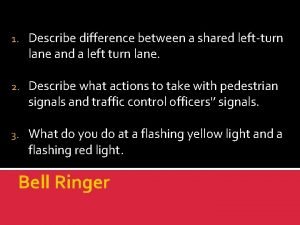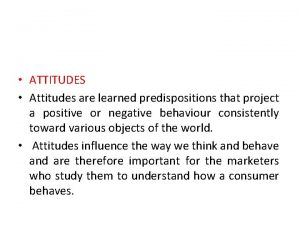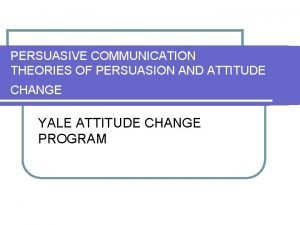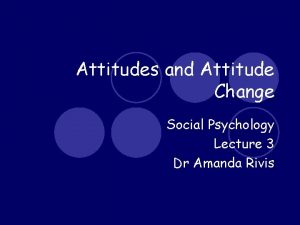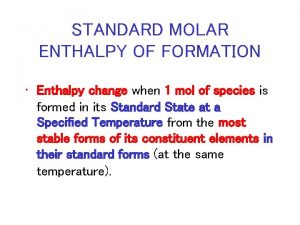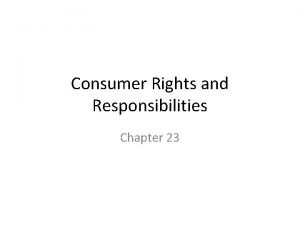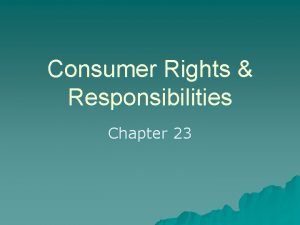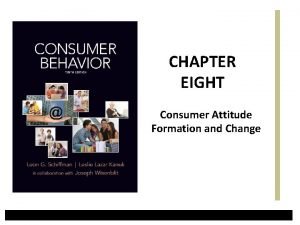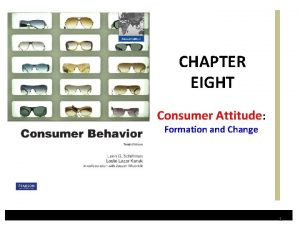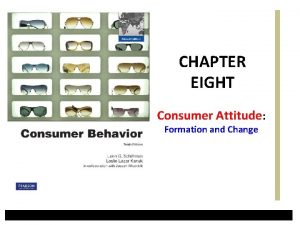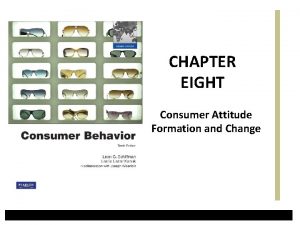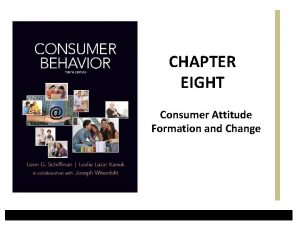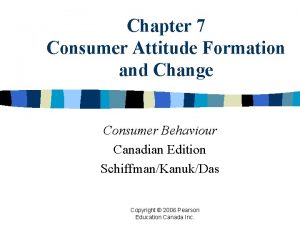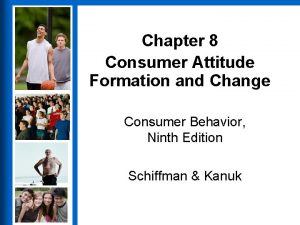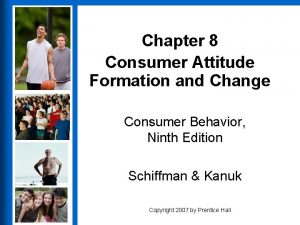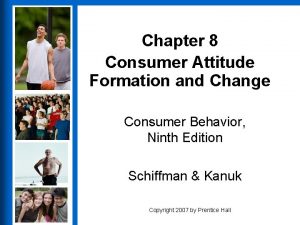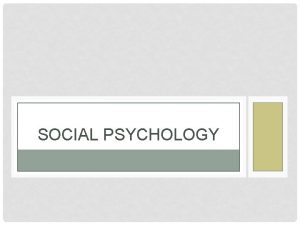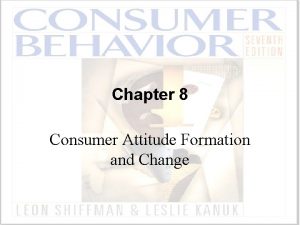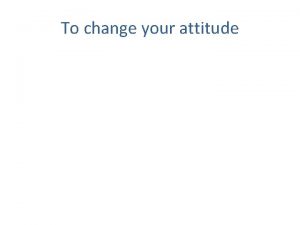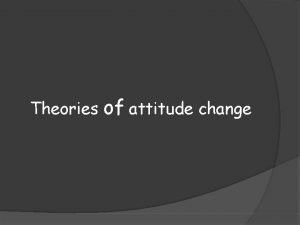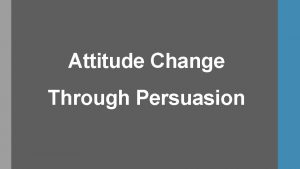CHAPTER EIGHT Consumer Attitude Formation and Change A



































- Slides: 35

CHAPTER EIGHT Consumer Attitude: Formation and Change

A Simple Model of Consumer Decision Making Copyright 2010 Pearson Education, Inc. Chapter One Slide 2

Overview First: Definition of Attitude Second: Tri-component model of Attitudes Third: Attitude formation Fourth: Attitude change Chapter Eight Slide 3

First: Definition of Attitude Introduction • We have attitudes toward many things (objects): e. g. people, products, brands, advertisements, ideas, places, activities. • The attitudes have been learned and guide our behavior toward the attitude object. Chapter Eight Slide 4

What Is Your Attitude Toward the Product Advertised? What Is Your Attitude Toward the Ad Itself? Are the Two Attitudes Similar or Different? You May Have Liked the Product but Disliked the Ad or Vice Versa Chapter Eight Slide 5

Attitude definition Attitude is a learned predisposition to behave in a consistently favorable or unfavorable manner with respect to a given object. Chapter Eight Slide 6

Concepts of attiudes • The attitude is toward an object which may be a store, product category , brand or anything else. • Attitudes are a learned predisposition, either through direct experience or from others. This predisposition may lead to a favorable or unfavorable behavior toward the object. • Attitudes have consistency, but are not necessarily permanent and can change over time. • Attitudes occur within a situation. Chapter Eight Slide 7

What Information Does This Ad Provide to Assist Consumers in Forming Attitudes Toward the Saturn Vue Hybrid? It is Stylish, Safe, and Good for the Environment Chapter Eight Slide 8

Relation Between Attitude and Behavior • It is fair to say that attitudes at least sometimes guide behavior • Thus it is important for marketers to understand the role of attitudes in purchase situations Chapter Eight Slide 9

Second: Tri-component Model of attitudes Attitudes consist of three components. A change in one component tends to produce related changes in the other components. Marketing mangers find it difficult to influence the consumer’s conation directly to buy the product, instead, they influence the behavior indirectly by providing information, Cognition music or other stimuli that influence a belief (cognition) or feeling (affection) about the product. Chapter Eight Slide 10

1 - Tricomponent Model Components • Cognitive • Affective • Conative The knowledge and perceptions that are acquired by a combination of direct experience with the object and related information from various sources (what we learn from others) Chapter Eight Slide 11

1 - Tricomponent Model Components • Cognitive • Affective • Conative A consumer’s emotions or feelings about a particular product or brand or any other object. These feelings often tend to be good or bad feelings. Chapter Eight Slide 12

1 - Tricomponent Model Components • Cognitive • Affective • Conative The likelihood or tendency that an individual will undertake a specific action or behave in a particular way with regard to the attitude object Example: tendency to buy a certain brand or from a specific store. Chapter Eight Slide 13

Implications of tri-component model for marketing strategy • When marketers use the tri-component model to create or change attitudes, they use the various components as follows: 1. At the cognitive level with information 2. At the affective level with emotionally toned messages 3. At the conative level with incentives (samples, coupons, rebates) Chapter Eight Slide 14

Third: Attitude Formation Knowing How consumer attitudes are formed is of vital importance to marketers in order to form consumer attitudes and influence their behavior toward their products. Consumer attitudes are learnt. Hence, marketers enhance the sources that influence consumer learning. Chapter Eight Slide 15

Sources of Attitude formation • Three Major Influences on Attitude Formation 1. 2. 3. 4. Personal experience Influence of family and friends Mass-media Exposure to direct marketing Chapter Eight Slide 16

1. Personal Experience • The primary basis on which attitudes towards goods and services are formed • Free products, cents-off promotions, etc. • Marketer’s goal is to get consumers to try a product and, hopefully, develop a positive attitude towards it Chapter Eight Slide 17

2. Influence of Family & Friends • Family and friends are a major influence on our values, beliefs and attitudes • We carry over into adulthood many of the attitudes we developed as children • Our peer and social groups also influence our attitudes Chapter Eight Slide 18

3. Mass Media • Mass media: - Television Radio News papers Magazines • Those media provide marketers with unlimited opportunities to create positive attitudes towards their products Chapter Eight Slide 19

4. Direct Marketing • Direct marketers are able to use new technologies to target smaller and smaller market segments • As a result, many marketers are highly personalized and have the capacity to create favorable attitudes towards their products Chapter Eight Slide 20

Fourth: Attitude Change Attitude change and formation are not all that different. They are both learned, they are both influenced by many factors such as: personal experience, personality effects, family influence, and marketing communications. Chapter Eight Slide 21

Strategies of Attitude Changing the Basic Motivational Functions Associating the Product with an Admired Group or Event Altering consumer’s brand evaluation Changing Beliefs about Competitors’ Brands Chapter Eight Slide 22

1 - Changing the Basic Motivational Functions An effective way to change consumer attitudes toward a product or a brand is to change his four motivational functions: Utilitarian Egodefensive Valueexpressive Knowledge Chapter Eight Slide 23

1 - Changing the Basic Motivational Functions • Utilitarian function is how the product is useful to us. A marketer might want to create a more consumer positive attitude toward a brand by showing utilities the brand can do. • ego-defensive function would show the product would make them feel more secure and confident (e. g. cosmetics that defense women’s appearance). • value-expressive function would more positively reflect the consumer’s values or lifestyle. • knowledge function would satisfy the consumer’s “need to know” and help them understand more. It is important for marketers to realize that they might have to combine functions because different customers are motivated to purchase their products for different reasons. Someone might buy a product because it tastes good and fills them up (utilitarian), while another thinks it is low fat and will make them healthy and therefore look better (ego-defensive). Chapter Eight Slide 24

Why and How Does This Ad Appeal to the Utilitarian Function? The Product is Green and Works as Well or Better than Other Products. Chapter Eight Slide 25

Which Lifestyle- Related Attitudes (value expressive) Are Expressed or Reflected in This Ad? Healthy Eating and Snacking Lifestyle Chapter Eight Slide 26

How Does This Ad Provide Information to Establish or Reinforce Consumer Attitudes? It Raises the Question About UVA Rays and then Provides Information (knowledge) n Sun Protection. Chapter Eight Slide 27

2 - Associating the Product with an Admired Group or Event • Attitudes are related, at least in part, to certain groups, social events, or causes. • It is possible to alter (change) attitudes toward companies and their products by pointing out their relationships to these groups, events, or causes. • Example: advertisement around the playground in football matches or events sponsorships. Chapter Eight Slide 28

Associating the Product with an Admired Group or Event The Fiji water’s link to Environmental Cause Likely to Impact Consumers’ Attitudes Toward Its Product. Accordingly, they Might Have a More Favorable Attitude toward the company and its product. Chapter Eight Slide 29

3 - Altering consumer’s brand evaluation – Changing consumer’s evaluation of attributes. Example: Perhaps the consumer thinks that the product fine to be inexpensive, but a marketer might be able to point out that it is often worth paying a bit more for better quality. – Changing brand beliefs. Example: Maybe a consumer thinks a brand is very expensive when in fact it is less expensive than several other brands. – Adding an attribute. Example: Who thought chewiness was an attribute that could even exist for a vitamin until Gummy Vites came along? – Changing the overall brand rating, not a single attribute of it. Example: using statements like: “ the one all others try to imitate” or “ the largest selling brand”. Chapter Eight Slide 30

How Is This New Benefit Likely to Impact Consumers’ Attitudes Toward the Product? The ad states that there is a link between one’s mouth health and the health of one’s whole body, changing the overall brand rating in the minds of target consumers Chapter Eight Slide 31

How Is the Absence of an Ingredient Likely to Lead to a Favorable Attitude Toward a Product? Adding an attribute (chewiness) to vitamins Chapter Eight Slide 32

4 - Changing beliefs about the attributes of competitors’ brands How Is Valvoline’s Attempt to Change Attitudes Toward a Competing Brand Likely to Impact Attitudes Toward Its Own Brand? By Showing Better Wear Protection Chapter Eight Slide 33

Central and peripheral routes of changing attitudes (Elaboration likelihood model) Elaboration Likelihood Model (ELM) Customer attitudes are changed by two distinctly different routes to persuasion: a central route or a peripheral route. Chapter Eight Slide 34

Elaboration Likelihood Model High Involvement Low Involvement Chapter Eight Slide 35
 Food web vs food chain
Food web vs food chain Whats a plane figure
Whats a plane figure A short section of corrugated roadway that warns of hazards
A short section of corrugated roadway that warns of hazards Consumer markets and consumer buyer behavior
Consumer markets and consumer buyer behavior Chapter 5 consumer markets and buyer behavior
Chapter 5 consumer markets and buyer behavior Attitude formation
Attitude formation Attitude examples
Attitude examples Attitude and value change
Attitude and value change Greenfly carnivore
Greenfly carnivore Consumer diversity in consumer behaviour
Consumer diversity in consumer behaviour Consumer behaviour research process
Consumer behaviour research process Persuasive communication
Persuasive communication Characteristics of attitudes
Characteristics of attitudes Formation initiale vs formation continue
Formation initiale vs formation continue Finding enthalpy of reaction
Finding enthalpy of reaction Bread toasting: gas formation color change light emission
Bread toasting: gas formation color change light emission Enthalpy change equation a level
Enthalpy change equation a level Chemical change formation of precipitate
Chemical change formation of precipitate Chemical change formation of precipitate
Chemical change formation of precipitate Standard enthalpy change
Standard enthalpy change Chapter 8 and 9 great gatsby summary
Chapter 8 and 9 great gatsby summary Chapter 9 lord of the flies
Chapter 9 lord of the flies Chemical change examples pictures
Chemical change examples pictures Absolute change and relative change formula
Absolute change and relative change formula Difference between chemical and physical change
Difference between chemical and physical change Supply and demand curve shifts
Supply and demand curve shifts Which is an example of a physical change
Which is an example of a physical change Rocks change due to temperature and pressure change
Rocks change due to temperature and pressure change Physical change and chemical change venn diagram
Physical change and chemical change venn diagram First-order and second-order change examples
First-order and second-order change examples Responsibilities of a consumer
Responsibilities of a consumer Chapter 23 consumer rights and responsibilities
Chapter 23 consumer rights and responsibilities Chapter 1 consumer powers and protections
Chapter 1 consumer powers and protections Chapter 5 consumer markets and buyer behavior
Chapter 5 consumer markets and buyer behavior Chapter 23 consumer rights and responsibilities
Chapter 23 consumer rights and responsibilities Chapter 6 consumer purchasing and protection
Chapter 6 consumer purchasing and protection


